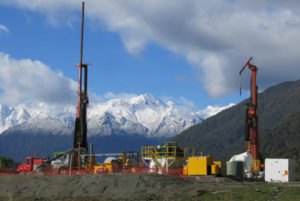@WFS,World Fossil Society,Riffin T Sajeev,Russel T Sajeev
An international team, including University of Southampton scientists, has found unusually high temperatures, greater than 100°C, close to Earth’s surface in New Zealand — a phenomenon typically only seen in volcanic areas such as Iceland or Yellowstone, USA.
The researchers made the discovery while boring almost a kilometre into the Alpine Fault, the major tectonic boundary between the Australian and Pacific plates -running the length of the country’s South Island. The team was working to better understand what happens at a tectonic plate boundary in the build-up to a large earthquake.
The Deep Fault Drilling Project (DFDP) borehole, was drilled at Whataroa to the north of Franz Josef Glacier and discovered extremely hot, highly pressured groundwater flowing near to the fault line. Water at temperatures of more than 100°C is normally only found at depths of over three kilometres, but in this case was encountered at just over 600m depth.
In an article published in the international journal Nature, computer models are used show these high temperatures result from a combination of the uplift of hot rocks along the tectonic plate boundary and groundwater flow caused by high mountains close to the Alpine Fault.
Professor Damon Teagle, who leads the Southampton group involved in the project, says: “The Alpine Fault extends over such a massive distance, it is visible from space. It is potentially New Zealand’s greatest geohazard, failing in the form of large earthquakes about every 300 years. With the last event occurring in 1717 AD, there is a high probability of a major (magnitude 7 to 8) earthquake in the next 50 years — making research into its behaviour all the more important.”
Thermal and hydrological computer modelling pre-drilling by University of Southampton PhD student Jamie Coussens, supervisor Dr Nick Woodman and other colleagues, helped predict the high temperatures and borehole fluid pressures to enable the safe drilling of this borehole. Their models, now calibrated against real sub-surface observations, explain how such high temperatures occur at shallow depths.
“The Southern Alps receive a lot of rain and snow — about ten times more than the UK. Much of this water flows into the ground, down beneath the high mountain ridges, before being heated and returning to the surface in valleys,” says Jamie Coussens. “The rocks that this water flows through are being moved upwards at about 10 mm a year on the Alpine Fault. This slip is very fast in geological terms and has carried up hot rocks from 30 km depth, faster than they can cool.”
Although warm springs are common in the region most of the hot groundwater flows up into, or near, the gravely beds of large rivers and becomes diluted at the surface by cooler river waters.
The result has implications for our understanding of the strength of the Alpine Fault and fault zones in general, as failure properties of fault rocks are influenced by temperature and geothermal fluids.
Professor Teagle comments: “The temperature profile of the DFDP borehole is really exciting. These very high shallow temperatures prove early theoretical models of rapid tectonic uplift first suggested in the 1980s for the Southern Alps by profound thinkers such as Peter Koons and Rick Allis. I was inspired by these theories as an undergraduate at the University of Otago in southern New Zealand — it is wonderful to see these early conceptual predictions proven with borehole observations.”
Source:University of Southampton
@WFS,World Fossil Society,Riffin T Sajeev,Russel T Sajeev



 June 3rd, 2017
June 3rd, 2017  Riffin
Riffin 
 Posted in
Posted in  Tags:
Tags: 